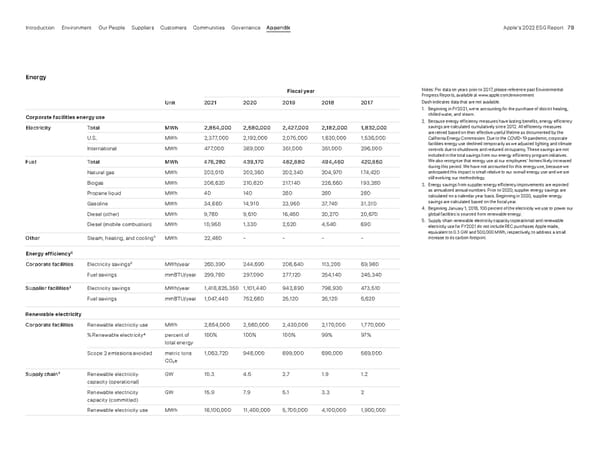Fiscal year Unit 2021 2020 2019 2018 2017 Corporate facilities energy use Electricity Total MWh 2,854,000 2,580,000 2,427,000 2,182,000 1,832,000 U.S. MWh 2,377,000 2,192,000 2,075,000 1,830,000 1,536,000 International MWh 477,000 389,000 351,000 351,000 296,000 Fuel Total MWh 476,280 439,170 462,680 494,460 420,650 Natural gas MWh 203,010 202,360 202,340 204,970 174,420 Biogas MWh 208,620 210,820 217,140 226,660 193,280 Propane liquid MWh 40 140 280 280 280 Gasoline MWh 34,880 14,910 23,950 37,740 31,310 Diesel (other) MWh 9,780 9,610 16,450 20,270 20,670 Diesel (mobile combustion) MWh 10,950 1,330 2,520 4,540 690 Other Steam, heating, and cooling 1 MWh 22,480 - - - - Energy efficiency 2 Corporate facilities Electricity savings 3 MWh/year 260,390 244,690 208,640 113,200 69,980 Fuel savings mmBTU/year 299,780 297,090 277,120 254,140 245,340 Supplier facilities 3 Electricity savings MWh/year 1,418,825,350 1,101,440 943,890 798,930 473,510 Fuel savings mmBTU/year 1,047,440 752,680 25,120 25,120 5,620 Renewable electricity Corporate facilities Renewable electricity use MWh 2,854,000 2,580,000 2,430,000 2,170,000 1,770,000 % Renewable electricity 4 percent of total energy 100% 100% 100% 99% 97% Scope 2 emissions avoided metric tons CO₂e 1,063,720 948,000 899,000 690,000 589,000 Supply chain 5 Renewable electricity capacity (operational) GW 10.3 4.5 2.7 1.9 1.2 Renewable electricity capacity (committed) GW 15.9 7.9 5.1 3.3 2 Renewable electricity use MWh 18,100,000 11,400,000 5,700,000 4,100,000 1,900,000 Notes: For data on years prior to 2017, please reference past Environmental Progress Reports, available at www.apple.com/environment Dash indicates data that are not available. 1. Beginning in FY2021, we’re accounting for the purchase of district heating, chilled water, and steam. 2. Because energy efficiency measures have lasting benefits, energy efficiency savings are calculated cumulatively since 2012. All efficiency measures are retired based on their effective useful lifetime as documented by the California Energy Commission. Due to the COVID-19 pandemic, corporate facilities energy use declined temporarily as we adjusted lighting and climate controls due to shutdowns and reduced occupancy. These savings are not included in the total savings from our energy efficiency program initiatives. We also recognize that energy use at our employees’ homes likely increased during this period. We have not accounted for this energy use, because we anticipated this impact is small relative to our overall energy use and we are still evolving our methodology. 3. Energy savings from supplier energy efficiency improvements are reported as annualized annual numbers. Prior to 2020, supplier energy savings are calculated on a calendar year basis. Beginning in 2020, supplier energy savings are calculated based on the fiscal year. 4. Beginning January 1, 2018, 100 percent of the electricity we use to power our global facilities is sourced from renewable energy. 5. Supply chain renewable electricity capacity (operational) and renewable electricity use for FY2021 do not include REC purchases Apple made, equivalent to 0.3 GW and 500,000 MWh, respectively, to address a small increase to its carbon footprint. Energy Appendix Governance Communities Suppliers Customers Our People Environment Introduction Apple’s 2022 ESG Report 79
 ESG Report | Apple Page 78 Page 80
ESG Report | Apple Page 78 Page 80